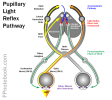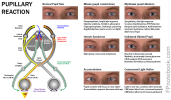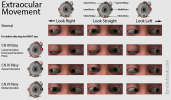II. Indications: Acute Complaints
III. Indications: Routine Eye Exams
- Black patients (higher risk of Glaucoma)
- Age 20 to 40: Baseline exam at age 20 years and then every 2-4 years
- Age 40 to 54: Every 1-3 years
- Age 55 to 64: Every 1-2 years
- White patients
- Age 40 to 54: Every 2-4 years
- Age 55 to 64: Every 1-3 years
- Age over 65: Every 1-2 years
V. Exam: Basic (primary care and emergency department) - Five Vital Signs of the Eye
- Visual Acuity
- Visual Field testing
- Pupilary light reflex and pupil size (Mydriasis, Miosis)
- Eye Neurologic Exam (including Extraocular Movements)
- Intraocular Pressure
VI. Exam: Comprehensive Eye Exam (Ophthalmology)
- Indications (see routine Eye Exam schedule above)
- Visual Acuity
- Dilated Eye Exam with Retinal Exam
- Tonometry
- Visual Field Testing
VII. Exam: Tools
- See Emergency Eye Kit
-
Funduscopic Exam (Retinal Exam)
- Strongly consider Mydriatic use in acute presentations where Retinal Exam is key (if not contraindicated)
- See Funduscopic Exam
- Retinal Artery Occlusion
- Retinal Detachment
- Papilledema
- Tonometry (e.g. Tonopen or Applanation Tonometry)
-
Slit Lamp
- Corneal Abrasion or other injury
- Foreign body
-
Globe Ultrasound
- Evaluate for Retinal Detachment
- Evaluate for Increased Intracranial Pressure
VIII. Exam: Eye Injury
- See Eye Injury in Sports
- See Work-Related Eye Injury
- See Blunt Eye Trauma
- Apply topical Anesthesia (e.g. topical tetracaine)
- Fluorescein
- Eye Acidity Test
- Upper Eyelid Eversion (and lower Eyelid Eversion)



